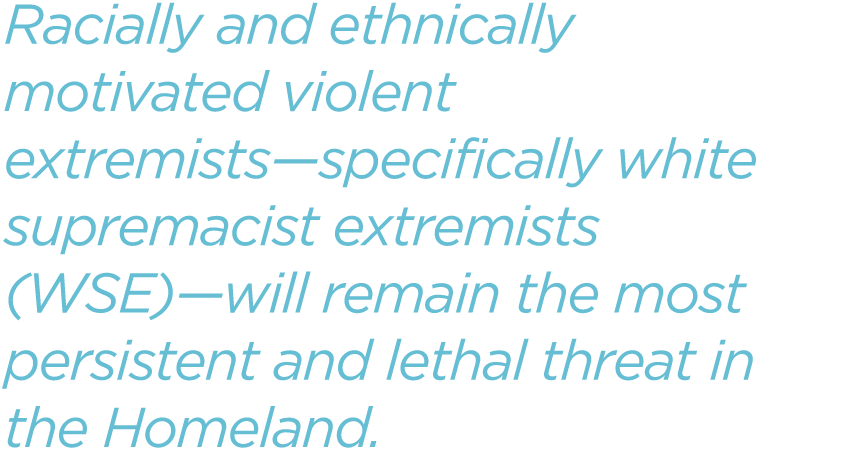Accelerationists Rising: The State of U.S. Hate Crimes
It was a horrific act of violence. On 3 August 2019, a gunman traveled 650 miles from his home to a major Walmart in El Paso, Texas, near the U.S.–Mexico border. After walking through the store to assess the clientele, the gunman returned to his vehicle, armed himself, put on protective equipment, and re-entered the Walmart where he opened fire.
He killed 22 people and injured numerous others in the deadliest mass shooting in the United States in 2019. Along with being charged with capital murder, alleged gunman Patrick Crusius, 21, also faces 22 counts of hate crimes resulting in death, 23 hate crimes involving an attempt to kill, and 45 counts of discharging a firearm in relation to the hate crimes.
U.S. federal prosecutors based the decision to charge Crusius with hate crimes after discovering he allegedly uploaded a document to the Internet—“The Inconvenient Truth”—on the same day as the shooting.

“This attack is a response to the Hispanic invasion of Texas,” the document said, according to the U.S. Department of Justice. “They are the instigators, not me. I am simply defending my country from cultural and ethnic replacement brought on by the invasion.”
In 2019, the United States saw hate crimes rise to their highest level in a decade to 7,314 reported incidents, according to the FBI’s Uniform Crime Reporting Program’s Hate Crime Statistics, 2019. Most striking within those reported incidents, however, was the rise in murders motivated by hate—51 in 2019 compared to 24 in 2018.
The El Paso shooting victims accounted for 22 of those deaths. And that incident is an example of what Cassie Miller, senior research analyst at the Southern Poverty Law Center, calls a troubling trend: the emergence of the accelerationist movement within the far right, which uses terroristic tactics to advance its goals.
“This wasn’t something that happened in a vacuum—it’s the reflection of a larger social movement that is focused on using violence to further their political project,” she adds.
Hate Crimes in 2019
Since the 1990s, the FBI’s Uniform Crime Reporting (UCR) Program has gathered hate crime data voluntarily submitted by law enforcement agencies throughout the United States. In 2019, 15,588 of approximately 18,000 agencies submitted data to the FBI that was compiled into the UCR’s annual report. The Western region of the United States submitted the most data, followed by the Eastern and Midwestern regions of the country, says Trudy Ford, FBI section chief of the global law enforcement support section of the FBI Criminal Justice Information Services Division.
As part of her work, Ford oversees the UCR program that compiles annual hate crime data to make it available to the public to review to better understand the scope of hate crimes in the United States. What the UCR has seen is that in a three-year period, there were more than 21,500 reported hate crime incidents: 7,314 in 2019, 7,120 in 2018, and 7,175 in 2017.
Most of the incidents in 2019—7,103—were single-bias hate crimes, where a victim was targeted because of his or her race, ethnicity, ancestry, religion, sexual orientation, disability, gender, or gender identity.
Of those crimes, 4,930 (57.6 percent) of victims were targeted because of their race, ethnicity, or ancestry. A majority of these incidents targeted individuals who were Black (48.5 percent); 15.7 percent of victims were targeted for being white; and 14.1 percent were victims of anti-Hispanic or Latino bias. In contrast, most of the known offenders (52.5 percent) who committed hate crimes were white, while 23.9 percent of hate crimes were committed by Black or African American individuals.
The UCR also revealed that there were 953 reports of crimes that targeted Jewish institutions and Jews in 2019, part of an overall 7 percent increase in religion-motivated hate crimes in 2019. Crimes against Hispanics also rose to 527 in 2019 from 485 in 2018.
The UCR Program does not analyze the data it collects from law enforcement agencies to assess motives or insights into the trends revealed, Ford says. However, the program does perform outreach and encourages all agencies to submit data on hate crimes, which they are not legally required to do.
The data that is reported likely underestimates the true number of hate crimes that do occur. Analysis found that 15,588 agencies that participated in the data collection effort did not report any instances of hate crimes in 2019.
“The total severity of the impact and damage caused by hate crimes cannot be fully measured without complete participation in the FBI’s data collection process,” said Jonathan Greenblatt, president of the Anti-Defamation League (ADL), in a statement.

Organizations like the ADL and the SPLC have pushed for changes in the Hate Crime Statistics Act, which went into effect in 1990 and requires the U.S. Department of Justice to publish an annual report on the violent and non-violent hate crimes documented by the nation’s law enforcement agencies. Ideally, the organizations say, all agencies would be required to report all hate crimes to the FBI to be included in the UCR Program’s reports, and agencies would be trained on how to properly document and file that data to be included.
A Rising Threat
Revealed in the data from the 2019 report is the growing threat that members of the far-right pose to the United States, which the U.S. Department of Homeland Security (DHS) disclosed in its much-delayed Homeland Threat Assessment in October 2020—an update to a report released more than a year prior.
Among domestic violent extremists (DVEs), “racially and ethnically motivated violent extremists—specifically white supremacist extremists (WSE)—will remain the most persistent and lethal threat in the Homeland,” the DHS assessment said.
WSEs were responsible for eight terror attacks that posed a threat to life in the United States between 2018 and 2019, and killed 39 people—the most of any extremist group in the United States in that timeframe.
“WSEs have demonstrated longstanding intent to target racial and religious minorities, members of the LGBTQ+ community, politicians, and those they believe promote multi-culturalism and globalization at the expense of the WSE identity,” DHS said.
DHS also found that some WSEs have engaged in outreach and networking with likeminded individuals outside the United States. “Such outreach might lead to a greater risk of mobilization to violence, including traveling to conflict zones,” DHS added.
The DHS assessment, combined with the 2019 hate crimes data, shows that the far right, which includes WSEs, is adopting more violent rhetoric and tactics to achieve its goals, says the SPLC’s Miller.
“We’ve seen the emergence of the accelerationist movement within the far right—that’s a more extreme strand of the white power movement focused on using terroristic tactics to further its goals,” she explains.
In the early days of U.S. President Donald Trump’s term, the alt-right—a coalition of white nationalist groups—emerged and attempted to gain some mainstream political power to have their views normalized. But after a 2017 “Unite the Right” rally in Charlottesville, Virginia, Miller says disillusionment set in for these groups that Trump was not as “extreme” as they had hoped he would be, and many lost faith in the political process in general.
In response, the movement transitioned to using more aggressive tactics, such as those in the El Paso shooting, to spur more violent action.

“Many of today’s white power activists venerate Timothy McVeigh, who committed the 1995 Oklahoma City bombing, and encourage others to carry out similar attacks,” according to the SPLC’s analysis of the 2019 hate crime figures. “This is the strategy of ‘accelerationists,’ who believe that violence is the only political tool at their disposal. For a growing segment of the white power movement, violence isn’t only a way to inflict harm on groups they deem inferior but a strategy to alert other white people to the perceived dangers of immigration, racial integration, and the decline of white people as a percentage of the American population.”
While this threat is rising—the number of white nationalist groups grew 55 percent between 2017 and 2019—there are some positive signs that it can be mitigated. The first was that both the FBI and DHS have acknowledged the domestic terrorism threat white supremacists, Miller says.
In an appearance before the U.S. House Homeland Security Committee in September 2020, FBI Director Christopher Wray said the FBI is most concerned about lone offender attacks “primarily shootings, as they have served as the dominant lethal mode for domestic violent extremist attacks,” adding that the top threat stems from DVEs that identify as “racially/ethnically motivated violent extremists.”
Now, there needs to be more resources to analyze that threat and greater transparency into the findings, Miller adds, such as the creation of a central database to track domestic terrorism investigations in the United States—a system that does not currently exist.
“We also need to look beyond the national security framework,” Miller says. “Historically, our tactic has been punishment and incarceration models for dealing with domestic terrorism. We’d like to see a shift away from that and towards a more preventative framework to understand how and why people become radicalized in the first place…to find ways we can intervene in that process.”
Shifting this framework will require investing in research, creating new programs, and implementing new outreach methods, such as through the U.S. Department of Education to connect with young people who may be at risk.
For instance, SPLC has been working with the Polarization and Extremism Research and Innovation Lab at American University’s program that is focused on trying to prevent radicalization in the first place.
“We’ve worked with them to put out a guide for parents and caregivers, warning signs of radicalization,” Miller says. “We’re in a dangerous place right now where people feel disillusioned and are spending so much time online. They can stumble onto parts of the Internet that can have negative consequences.”
Megan Gates is senior editor at Security Management. Connect with her at [email protected]. Follow her on Twitter: @mgngates.
